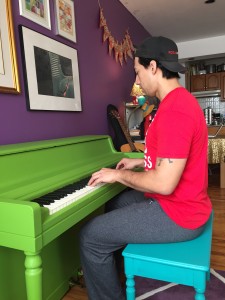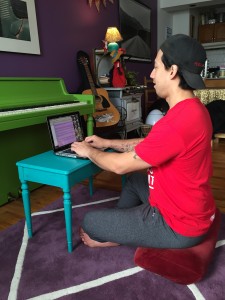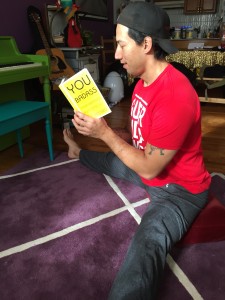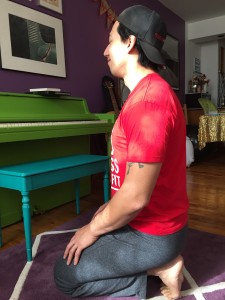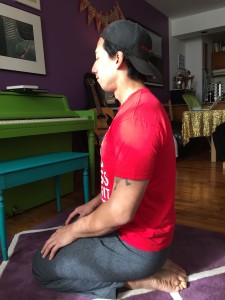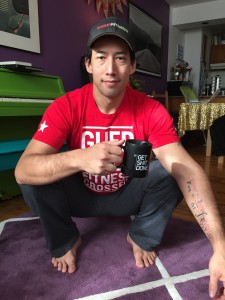If you’re looking to get stronger, healthier, fitter, lose weight and be more dominant on the mat, then you need to squat. Squats are an essential human movement. We sit and stand every day when we get up off the couch or off the toilet. It’s essential to our lives as human beings. Essential in the sense that if we lose the ability to squat, we lose the ability to live independently and our quality of life is greatly diminished. People that claim that they cannot squat for a variety of reasons have accepted decrepitude. They have resigned themselves to the inevitable decline that ends with them in a scooter cruising around the grocery store and living with an aide that cleans your creases. Learning and practicing basic squat mechanics and reclaiming this movement that came easy in our youth is a refusal to submit to aging and physical decline.
As an exercise, squats have the ability to strengthen not only the legs, but the back, the core and the lungs. Squatting also helps maintain flexibility by moving the ankles, knees, and hips through a normal, healthy range of motion. There are many varieties of squats, however only a few mechanical considerations which are universally accepted.
– The feet must remain flat on the floor. Weight shifting to the toes or the inside edges of the feet is to be avoided by shifting the weight back into the heels and actively trying to push the knees away from each other.
– The knees should point in the same direction as the toes. This not only helps keep the feet flat, but it puts the knee in the safest position: where the kneecaps point in the same direction as the middle toe. STarting with the toes turned out about 30 degrees is a good place to start.
– Athletes must learn to squat until the hip crease passes below the top of the knee. This below parallel position is extremely challenging because it is right at this point where the squat wants to fall apart, but maintaining proper mechanics throughout this range of motion builds the strongest squats and strengthens your muscles at the end range where they are most likely to fail.
– The squat is initiated by sitting back as if into a chair. This mimics our everyday movement pattern of sitting our butts down onto an object. Also by sitting back we learn to balance by bringing our head forward. Balance is a perishable skill that also needs to be practiced often lest we lose it (pun intended). Sitting back also helps maintain even weight on the feet and helps get the knees to line up with the toes.
– Maintaining a neutral spine. The Chinese say, “you are as old as your spine.” Thus a healthy spine is the key to longevity. The squat, done correctly, is a functional and safe way to progressively load the spine and keep it healthy. Start standing up straight and brace your spine by contracting all the muscles of the core and back so that the spine cannot bend while you are squatting. Movement should be limited to the ankles, knees, and hips.
By adhering to those five basic points of performance, squats can be done safely in all populations. Insist that all five points of performance are adhered to the best extent possible for the given athlete. If range of motion cannot be achieved, the athlete can still squat but the long-term goal would be to increase their range of motion so that they can get on and off the toilet by themselves.
There are many ways to squat and you should try them all. Air squats, back squats, front squats, overhead squats, zercher squats, goblet and many more. The style of squat mostly depends on the equipment you use and where you hold it. First start with a basic air squat (unloaded) and work on the basic mechanics. As you practice work on increasing your reps. Starting with sets of 5 to 10 is easy enough to maintain the basic points of performance. Then gradually increase the reps to 20, 30, and beyond. As fatigue starts to increase your form will decrease and you must do your best to maintain proper mechanics as the intensity increases.
Next step is to add some weight. I recommend a goblet squat. Grab a dumbbell, kettlebell, medicine ball, or some similarly heavy object between 15 and 50lbs. Hold the weight like a goblet under your chin with your elbows down and hands up as if you are about to take a sip from the challis. Squat down just like you did in the air squat. Usually with a light load, you will immediately notice some improvements in form: better balance, lower depth, more upright posture, and greater ability to have the knees track the toes. Again start at about 5 to 10 repetitions. You will most likely be limited by fatigue in the arms and shoulders from holding the weight. That’s fine. You will gain some strength and stamina by doing more of these. As with the air squat, slowly increase your repetitions until you can do sets of 50 or more with a light weight.
When you get to the point that you can do 100 air squats in a row or 50 goblet squats in a row, you will notice not only that your legs are stronger, but that your cardio is vastly improved. The benefits to your health and fitness are obvious and you will notice that your jiu-jitsu improves as well, especially regarding your passing game. Having strong legs as well as the conditioning to squat many many times will allow you to push the pace hard inside someones guard and not slow down due to fatigue. That’s only the start though. Continued progress will come from finding many different ways to make your stronger and better. The goal now is to gradually pick up heavier objects and put them on shoulders while you squat. What about reps? Jiu-jitsu doesn’t happen in sets of 5 or 10. Your training should be varied between light weight for high reps, moderate weight for moderate reps, and heavy weight for low reps. Also change the stimulus between front squats, back squats, overhead squats and zercher squats, and change the equipment from barbells, to dumbbells, to kettlebells, and to sandbags. Spend less time worrying about what to squat or how much to squat and just squat!

